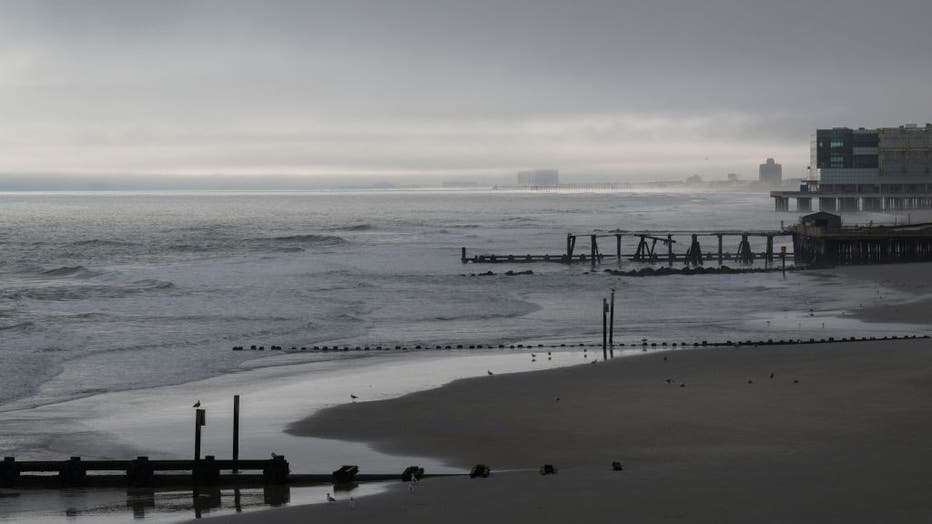10 years after Hurricane Sandy: Are we prepared for the next storm?

10 years after Superstorm Sandy
FOX 5 News looks at how things have changed since Hurricane Sandy tore through the New York City region, causing billions of dollars in damage.
NEW YORK - It’s been ten years since Superstorm Sandy ravaged our area, devastating communities from the Jersey shore to Long Island.
While the storm taught many lessons, the question remains: Are we better prepared today should another Sandy-type storm hit again?
At Andrew’s Diner in Great Kills nearby residents are grabbing a bite to eat on a chilly fall Wednesday in mid-October. The conversation is much different now than it was ten years ago. At that time, Superstorm Sandy was just starting to form in the Caribbean.
"So we got batteries, and we had our flashlights. We knew where our candles were, never thinking we were going to need them and continue to need them. Because it wasn't just one day," said Carol Pagliuca of Richmondtown, Staten Island.
"We had many storms right before that. I think Irene was right before that. And it was a total dud," said Mary Bisignano of Annadale.
Sandy, of course, was anything but. The storm struck overnight, but it wasn’t until daybreak that reality set in.
Those living on Staten Island still remember the shock of what they saw, and what they didn’t.
Get breaking news alerts in the free FOX5NY News app! | Sign up for FOX 5 email newsletters
"Nothing. No people. Nothing. Things outside, things floating. Nothing but water. And the devastation when water recedes," said Pagliuca.
"There were boats in people’s yards, there were cars in people's yards. I mean, literally lifted by a surge that we had never known in our lifetime," said Bisignano.
"I saw people for the last time," said Gus Plaitis, the general manager of Andrew’s Diner.
Ten years ago, hours before Sandy hit, Plaitis kept serving meals until he was told to evacuate. One of the last people he served was a father and his son. They both went back to their home in Oakwood Beach that night.
"I remember talking to him. "I was like, ‘Hey, you know where you're going?’ He's like, ‘Oh, my wife and the kids are going to be staying with my sister-in-law’. And he's like, ‘during Hurricane Irene, when everybody was asked to leave these areas, a lot of the houses were actually robbed’. We lost him, and we lost his son, too," said Plaitis.

A general view of the beach in Atlantic City, New Jersey on October 26, 2022. (Photo by ANGELA WEISS/AFP via Getty Images)
In the U.S. the storm killed an estimated 233 people, with most of the deaths on Staten Island. The storm surge in some parts of our area reached nearly 15 feet.
A lot changed that day, especially how the city, state, and federal agencies came together to respond.
The city recently broke ground on a coastal resiliency project, to install one hundred flip-up gates, measuring nine feet tall, to protect three miles worth of vulnerable waterfront sections of the city from storm surge. It’s a project that is on track to be completed in 2026.
"Once this is in place, moveable floodwalls will protect the Two Bridges neighborhood in Manhattan when needed," said Mayor Eric Adams.
The recovery after Sandy is also keeping the Governor’s Office very busy.
"We purchased 720 storm-damaged properties statewide, including 500 in Oakwood Beach, Grand Beach and Ocean Breeze on Staten Island. What that really does is creates a coastal buffer that protects the community," said Katie Brennan, the Executive Director of the Governor’s Office of Storm Recovery.
And FEMA, which continues working on mitigation projects to help in the next storm.
"The Department of Environmental Protection in Oakwood Beach, their wastewater treatment plant, we're funding that. That’s going to start next year and that's going to provide them a new pumping station. It's going to make them more storm ready," said Andrew D’Amora, FEMA Deputy Regional Administrator.
Back at Andrew’s Diner on Staten Island, residents are cautiously optimistic the city is prepared for another massive storm.
"If we do have water here, or that kind of devastation, I think their response will always be the way it was. They were here right away. They tried to do whatever they could for as many as they could, but they needed help, too. They needed manpower," said Pagliuca.
"People become complacent. I think the same thing will happen again. But I think that having Superstorm Sandy in the back of your head gets you a little bit more prepared," said Bisignano.
More prepared for when, not if, another major storm hits our area again.

